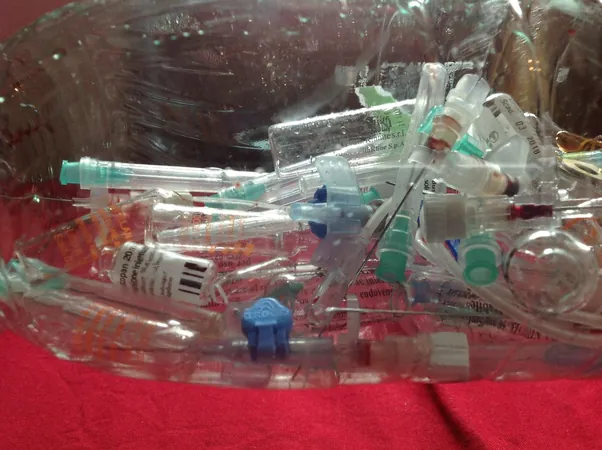
Revolutionizing Healthcare: How Plant-Based Plastics Could Slash Medical Waste for Good!
2025-03-13
Author: Sophie
Hospitals around the globe produce a staggering amount of plastic waste each year—millions of tons, to be exact. The primary culprits behind this environmental dilemma are single-use medical items, including face masks, surgical gloves, syringes, IV tubes, and sterile packaging materials. Alarmingly, the majority of these products are non-biodegradable, leading to their lingering presence in landfills and oceans for centuries. Eventually, they break down into harmful micro- and nano-sized particles, posing serious risks to both human health and the environment, such as endocrine disruption and cellular damage.
The incineration of this medical plastic waste isn't any better; it releases toxic chemicals into the atmosphere, aggravating air quality and potentially contributing to global warming. With these pressing issues at hand, there’s an urgent call for eco-friendly alternatives—a solution may lie in the innovative realm of bioplastics.
The Promise of Bioplastics
Bioplastics, like polylactic acid (PLA), are emerging as viable alternatives to traditional medical plastics. Made from renewable sources such as plants and algae, these materials can naturally decompose under specific temperature, pH, and moisture conditions without producing toxic byproducts over time. Furthermore, natural fibers like bamboo and hemp are also being explored for their potential to replace synthetic materials, combining strength with biodegradability.
In the medical field, the potential applications for bioplastics are vast. They are already being utilized in various medical devices, such as heart valves, wound dressings, and drug delivery systems. One of the advantages of bioplastics is their ability to be reabsorbed by the body during the healing process, eliminating the need for a second surgery to remove implants. They can even navigate biological barriers like the blood-brain barrier, making targeted treatments more feasible.
Innovations Driving Sustainability
Exciting advancements in technology, such as 3D-printing with biodegradable materials, are paving the way for sustainable medical applications. Researchers are investigating the use of 3D-printed bioplastics for creating replacements for load-bearing cartilage, repairing heart chambers, and even crafting artificial membranes for kidneys. Among these materials, cellulose stands out as a promising bioplastic due to its non-toxic nature, mechanical strength, and waterproof characteristics—essential traits for medical packaging.
Moreover, polymers like polycaprolactone (PCL) and polylactic-co-glycolic acid (PLGA) are gaining traction for their safety and compatibility in medical applications. Implants made from polyhydroxyalkanoate (PHA), a type of bioplastic, demonstrate the ability to naturally degrade within the human body, further minimizing the need for invasive removal procedures. Surgical sutures made with PLA can dissolve over time, potentially lowering the risk of infection.
Addressing the Roadblocks
Despite the promising future of bioplastics in the medical sector, challenges remain. Although many consumers are eager to see more environmentally-friendly options, significant hurdles such as sterilization, safety, and regulatory approvals must be addressed before widespread adoption can occur. Financially, medical bioplastics often come with a higher price tag—up to 50 percent more expensive than their oil-based counterparts—despite their potential to positively impact the environment.
Another critical challenge lies in ensuring that the biodegradable materials can meet the strict safety and sterility standards required for medical use. Comprehensive life cycle assessments are essential for evaluating the environmental impacts of these bioplastics throughout their entire lifespan, from raw material extraction to end-of-life disposal. By conducting and publishing these assessments, stakeholders can better determine the viability of integrating bioplastics into healthcare systems.
The Bottom Line: A Greener Future Awaits
The potential benefits of bioplastics in healthcare are monumental. Transitioning away from single-use plastics could drastically lessen the waste burden faced by health care systems while also safeguarding ecosystems and human health from the risks associated with microplastic pollution. Some bioplastics have even been shown to reduce greenhouse gas emissions by up to 25%.
Real change won’t happen overnight, but by investing in biodegradable alternatives, the healthcare sector can significantly minimize its plastic footprint, protecting our planet for future generations. The push for plant-based plastics in hospitals isn't just a trend—it's a necessary evolution in our fight against environmental degradation. Let's embrace this green revolution in healthcare!









 Brasil (PT)
Brasil (PT)
 Canada (EN)
Canada (EN)
 Chile (ES)
Chile (ES)
 Česko (CS)
Česko (CS)
 대한민국 (KO)
대한민국 (KO)
 España (ES)
España (ES)
 France (FR)
France (FR)
 Hong Kong (EN)
Hong Kong (EN)
 Italia (IT)
Italia (IT)
 日本 (JA)
日本 (JA)
 Magyarország (HU)
Magyarország (HU)
 Norge (NO)
Norge (NO)
 Polska (PL)
Polska (PL)
 Schweiz (DE)
Schweiz (DE)
 Singapore (EN)
Singapore (EN)
 Sverige (SV)
Sverige (SV)
 Suomi (FI)
Suomi (FI)
 Türkiye (TR)
Türkiye (TR)
 الإمارات العربية المتحدة (AR)
الإمارات العربية المتحدة (AR)